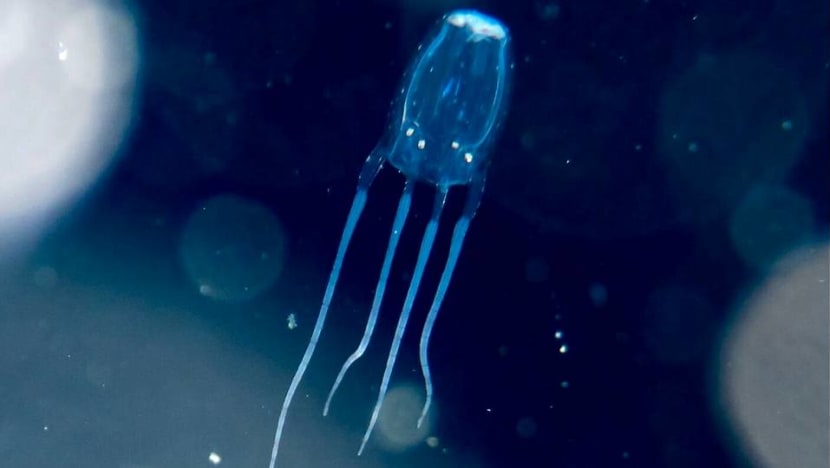Under the sea: What you need to know about the dangerous box jellyfish

A box jellyfish photographed off the coast of Indonesia in June 2019. (Photo: Wikimedia Commons)
SINGAPORE: Box jellyfish have been spotted at various locations around Singapore at least four times since March. On at least one occasion, a person was stung by the marine animal.
Here is what you need to know about the box jellyfish, a venomous creature often described as being among the deadliest in the world.
WHAT IS A BOX JELLYFISH?
The name “box jellyfish” is an umbrella term for about 50 species of box jellyfish, also called sea wasps. Of these, only a few species have venom that is lethal to humans, according to the United States National Ocean Service (NOS). One of them is the Australia box jellyfish or "chironex fleckeri" - the largest of the class.
The box jellyfish gets its name from the cuboid shape of its bell. It is pale blue and transparent. Mature jellyfish can grow up to about 3m in length and 2kg in weight. Unlike other jellyfish, box jellyfish can propel themselves through water rather than just drifting, according to National Geographic.
WHERE ARE BOX JELLYFISH USUALLY FOUND?
Box jellyfish are primarily found in warm coastal waters off northern Australia and around the Indo-Pacific, according to the US NOS.
The official season for box jellyfish off northern Australia is October to May, but stings have been recorded in all months of the year, according to the centre for disease control of Australia's Northern Territory government.
In Singapore, local marine conservation group Marine Stewards has reported sightings of box jellyfish in the waters off Palawan Beach, Pulau Seringat, Lazarus Island, Tuas, One Degree 15 Marina Sentosa Cove, Tuas and East Coast Park since March.
The National Parks Board (NParks) is working with the National University of Singapore to run environmental DNA analysis on water samples from various coastal areas to detect the presence of the box jellyfish.
READ: NUS researchers discover creatures, some possibly new, in depths of Pacific Ocean
CAN YOU DIE FROM A BOX JELLYFISH STING?
Box jellyfish are highly venomous, according to Dr Karenne Tun, director of the coastal and marine branch of NParks’ National Biodiversity Centre.
A sting from the box jellyfish is extremely painful and can cause severe hypertension, extreme lower back pain, nausea, cardiac and respiratory arrest. It can also cause fatalities, said Dr Tun in a statement responding to CNA's queries.
Multiple deaths around the world have been recorded from box jellyfish stings.
Between 1997 and 2015, 15 cases of severe stinging by box jellyfish were recorded at Koh Samui and Koh Pha Ngan in Thailand. Six of the cases were fatal, according to an article in the scientific journal BMC Research Notes.
In 2010, 10-year-old Australian schoolgirl Rachael Shardlow made headlines after surviving severe jellyfish stings that left her unconscious while swimming in an estuary in Queensland.

Survivors can still experience considerable pain for weeks after being stung and often have scars where the tentacles made contact, according to National Geographic.
WHAT SHOULD YOU DO IF YOU SEE A BOX JELLYFISH?
Members of the public should call the NParks helpline at 1800 471 7300 if they spot box jellyfish, said Dr Tun. People should not attempt to handle the jellyfish directly.
If the jellyfish was spotted at Sentosa, members of the public can also call 1800 726 4377 or approach a beach patrol officer for assistance.
HOW CAN YOU AVOID GETTING STUNG BY A JELLYFISH?
The best way to avoid getting stung is not to go into waters where there might be box jellyfish, according to the centre for disease control of Australia's Northern Territory government
Local marine conservation group Marine Stewards has advised people not to swim at Sentosa, Pulau Seringat, Lazarus Island and St John's Island for the next two weeks as sightings of box jellyfish have been reported at these locations.
If there is a need to enter the water, people should wear stinger suits or long-sleeved protective clothing, according to Australia's Northern Territory government.
WHAT SHOULD YOU DO IF STUNG BY A JELLYFISH?
“If stung by a jellyfish, one should rinse the affected area with seawater or vinegar and not try to remove the tentacles, and seek medical attention immediately,” said NParks’ Dr Tun.
Putting “plenty of vinegar” on the jellyfish stings stops any cells that have not released venom from doing so, according to Healthdirect Australia, a government telehealth service.














